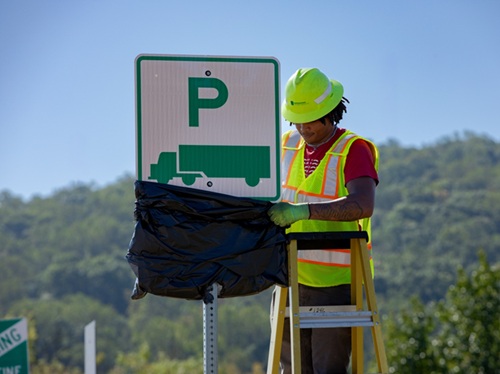The Federal Motor Carrier Safety Administration is awarding over $463 million in grants via its Motor Carrier Safety Assistance Program or MCSAP to states to reduce crashes, fatalities, and injuries involving commercial motor vehicles or CMVs.
[Above photo by the Virginia DOT]
FMCSA said that includes funding to state and local law enforcement agencies as well as other government entities for safety inspections of trucks and buses, investigations of motor carriers in response to safety concerns, and audits of new trucking and bus companies to ensure the safe movement of goods and passengers across the United States.

These grants come after a significant rise in fatalities involving large trucks. Preliminary 2021 data issued by the National Highway Traffic Safety Administration indicates large-truck related fatalities increased 13 percent increase compared to 2020.
The agency added that the $1.2 trillion Infrastructure Investment and Jobs Act or IIJA enacted in November 2021 included a 52 percent increase in MCSAP formula grants, which all 50 states, the District of Columbia, and the U.S. territories of American Samoa, Guam, the Northern Mariana Islands, Puerto Rico, and the U.S. Virgin Islands are eligible to receive.
“FMCSA’s core mission is safety, and our work supports the U.S. Department of Transportation’s comprehensive National Roadway Safety Strategy working towards zero fatalities on our roadways,” noted FMCSA Deputy Administrator Robin Hutcheson in a statement. “MCSAP grant funding is an important tool to help reduce large truck crashes by supporting critical CMV safety programs in every state.”
That safety funding comes as state departments of transportation are working on ways to make the nation’s freight network safer and more efficient.

During a panel discussion held during the 2021 annual meeting of the American Association of State Highway and Transportation Officials, state DOTs talked about their role in improving freight connectivity across the country.
“We have to ask ourselves several questions,” noted Caroline Mays, director of the freight, trade, and connectivity section within the Texas Department of Transportation. She also serves as vice chair for AASHTO’s Special Committee on Freight.
“It’s about what state DOTs do for the movement of freight and how can we adapt and innovate to solve mobility and equity issues within the country’s supply chain,” she said. “How do we help our leaders make decisions on freight issues and the direction of transportation as a whole? What action can we take now and in the future as we update state freight plans? And what will those changes look like?”
[Editor’s note: AASHTO made similar arguments in a 21-page letter sent to the USDOT in October 2021 containing advice on how to improve the nation’s supply chains and transportation industrial base.]
Mays noted that state DOTs also need to reinforce and expand their partnerships both in government and in the private sector as they work to improve freight flows across the United States.
“We also need to think outside the box and examine what new partnerships we need to build in order to deal with supply chain challenges we are facing,” she added.
 Nation
Nation
WVDOT Profiled in Latest State DOT 2-Minute Update
October 10, 2025 Nation
Nation

